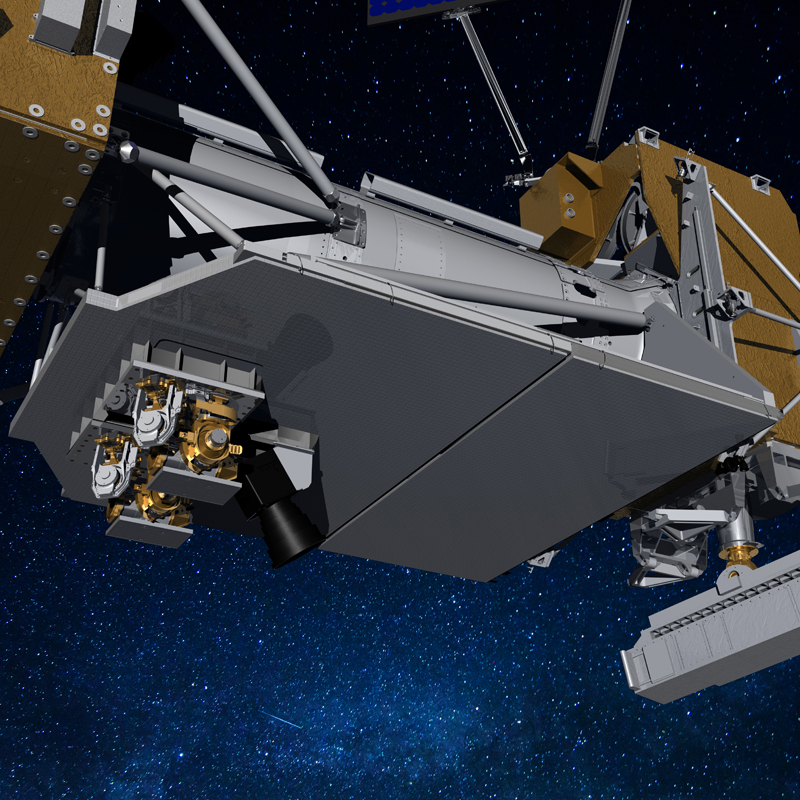Without a doubt, the free space optics (FSO) community has its work cut out right now. As the demand for data continues to rise and radio wavebands become congested, laser communications offer the potential to open up a far less busy portion of the electromagnetic spectrum, bridge the digital divide, and deliver blisteringly fast data transmissions.
But a quick glance at the FreeSpace Laser Communications XXXIV conference at SPIE Photonics West reveals that myriad challenges still persist. From honing laser beam pointing accuracy and reducing laser system power consumption to ensuring uplink laser safety and efficient constellation connections, researchers and engineers worldwide are racing to deliver results. And this isn't surprising given recent analysis from Global Market Insights predicts the FSO market will mushroom by an order of magnitude from some $200 million to $2 billion by 2027.
"For the first time since the 1960s, when the first tests were done on laser communications, there is a very real application in front of engineers working in the field," highlights Dr. Hamid Hemmati, Vice President and Chief Technology Officer of the US satellite broadband player, ViaSat, which uses geostationary satellites to provide Internet access. "In the past, the market has only required a handful of optical transceivers every year but given the growing constellations of satellites in low Earth-orbit, this is now scaling to thousands per year."
According to Hemmati, who opened the Photonics West Free-Space Laser Communication session with Dr. Bryan S Robinson of MIT Lincoln Lab, companies already providing optical transceivers for flight include SA Photonics, US, and Germany's Tesat Spacecom and Mynaric. Meanwhile businesses such as SpaceX and Amazon are also developing optical transceivers inhouse. Still, as Hemmati points out volume manufacturing is an issue for everyone and component costs need to drop substantially.
"Companies are getting squeezed in terms of cost of flight transceiver, manufacturing times and delivering higher data rates than ever before," he says. "Solutions include designing modular systems that can be put together without a lot of expertise and adding as much automation as possible — which isn't simple given the tight tolerances of optics. But I think companies welcome the challenge and the market potential is encouraging many to be innovative."
‘A solution beyond radio'
Jean-Franois Morizur, Founder and CEO of France-based photonics components and systems developer, Cailabs, concurs. As he highlights: "Right now, the game is to provide a solution beyond radio... The market for free-space optical communication has a door opening because we are reaching a point where radio cannot move forward for fundamental reasons, including available bandwidth. So I see this friction and I think as the optical community we have to recognise this and say we can take you beyond radio with optics."

Jean Franois Morizur, CEO of Cailabs. Credit: Cailabs
A key challenge for the FSO community is atmosphere turbulence. Fog, rain, and other air movements scatter the laser light as it travels from a low Earth-orbiting satellite to ground-stations, degrading the signal and reducing the reliability of long-range links. To counteract this, highly sensitive FSO receivers have been used to process incoming multimode light, but given the large footprint of many such systems, Cailabs pioneered a compact, spatial mode demultiplexer based on Multi-Plane Light Conversion (MPLC). And this is now making in-roads to the latest FSO communications receivers. The technology comprises a series of phase plates and lenses that shape the multimode light from a satellite into different single modes, ready for recombining into a single-mode fiber. Early results indicated that using a MPLC-based spatial mode demultiplexer increases signal collection at the FSO communications receiver, even following strong atmosphere turbulence. As Morizur highlights: "We presented a paper on using a MPLC spatial mode demultiplexer for turbulence mitigation at Photonics West 2019 and our story has basically accelerated from here."
Indeed, Cailabs is now playing a key role in the €5.5 million ($6.2 million) Keraunos project, funded by the French Defense Innovation Agency to tackle atmosphere turbulence during FSO communications. Here, a nanosatellite, designed and launched into low earth orbit by France-based satellite start-up, Unseenlabs, will transmit a signal to a ground-based station with a FSO receiver that contains Cailabs' spatial mode demultiplexer. Tests have started and Morizur reckons the nanosatellite could launch later in 2022. "Atmopspheric mitigation is a challenge and ambitious, but the Keraunos project will accelerate development here," he says.

Demultiplexing light with multi-plane light conversion from Cailabs. Credit: Cailabs
In the meantime, Morizur's colleague, Guillaume Labroille also presented recent Cailabs research at Photonics West, in which its spatial mode demultiplexer has been combined with a lithium niobate photonic integrated circuit (PIC) to process incoming atmosphere-disturbed signals. "I also see a lot of people excited about using PICs because these simplify the design of any system that deals with turbulence," highlights Morizur.
Indeed, just south of Paris, France, Dr. Vincent Billault and colleagues from Thales Research & Technology and Thales Alenia Space, Toulouse, have developed a prototype FSO receiver that includes a Cailabs MPLC module and their custom-designed photonic integrated circuit. Here, the demultiplexed light is shunted into the PIC where it is re-combined to single-mode light, on chip, ready for highspeed transmission.
Billault presented results at Photonics West and believes he and colleagues are amongst the first to use PICs — adaptive optics are an alternative option that have found success in many FSO receiver set-ups. "We developed a photonic integrated circuit as you can pack a lot of optical and electrical functions onto the chip and that's very interesting for the scalability, the footprint and the thermal and mechanical stability of the multi-mode laser light combiner," he says.
The Thales-designed PIC was fabricated within the silicon on insulator photonics foundry at Belgium-based nanoelectronics research center, imec, and packaged by integrated photonics packaging foundry, Phix, of The Netherlands. It comprises numerous phase shifters, Mach-Zehnder interferometers and photodiodes in a small footprint, which according to Billault, combined with the spatial demultiplexer, delivers a robust and adaptable system package. Indeed, Thales Alenia Space is keen to develop the product further.

The Thales PIC, as packaged by Phix. Credit: Phix
To test their receiver, the researchers designed an atmospheric perturbation emulator to mimic an entire optical link from satellite to receiver. So far, results indicate their set-up is strongly resilient to phase and amplitude perturbations compared to conventional single-mode fiber FSO receivers. As Billault highlights: "I believe the whole mindset of the FSO sector is now shifting towards optical solutions."
"It's going to take some time to have these optical elements specified for space... but we're excited about our latest results because they prove that photonic integrated circuits can be implemented in space solutions," he adds. "PICs provide low weight, low power consumption and high flexibility, and this will be key for the future development of satellite applications."
Greece-based start-up, LEO Space Photonics, is also making waves in the world of satellite optical communications. From the word go, CEO and company founder, Dr. Leontios Stampoulidis, and colleagues, have focused on making electronic and photonic transceiver ICs for laser communications (lasercom) between satellites, and have been instrumental to key, multi-million dollar European Horizon 2020 projects. One such project, ORIONAS, has developed optical transceivers and amplifiers for lasercom modems with a view to delivering >50 Gb/s direct and coherent detection links to the world's growing army of satellite constellations.

PICs for satellite laser communications from LEO Space Photonics. Credit: LEO Space Photonics
As the project draws to an end, Stampoulidis presented results at Photonics West, which as he highlights, are critical to reducing the cost, complexity and size of lasercom terminals for high-speed satellite constellation interconnectivity. Researchers have been working with BiCMOS and InP foundries to squeeze transceiver and amplifier elements into ICs of only a few square millimeters while co-packaging modulator PICs with laser diodes and developing radiation-resistant fiber pre-amplifiers.
The next steps are to ensure all fabrication processes are repeatable and reliable as device testing takes place at Thales Alenia Space.
"This is all about progressing the sustained entry of photonics integration in satellites, which is so important," says Stampoulidis. "Today we have only two mission-critical mini constellations in the sky that use lasercom — the European and Japanese data relay systems — but tomorrow is going to be very different... in the last decade around 500 telecom satellites were launched in total but almost overnight, SpaceX launched 60 in one day, and projections indicate that the industry will launch 30,000 satellites from 2020 to 2030."
"If we're talking about tens of thousands of satellites then cost is an issue — we need to make systems much more compact, densely integrated and cost-effective, and photonics integration is going to play a role," he adds.
NASA testing FSO in space
Clearly industry progress is rapid. For example, NASA's Laser Communication Relay Demonstration, aboard the US Department of Defense's Space Test Program Satellite-6, will test laser communications from geosynchronous orbit to Earth. And in addition to the proposed nanosatellite to Earth link from the French Keraunos project, Stampoulidis points to similar endeavors, including a Photonics West presentation from Kathleen Riesing at MIT Lincoln Lab on the Terabyte Infrared Delivery program. Here, MIT researchers are working with NASA, Ames Research Center and the Goddard Space Flight Center, to deliver record-fast, 200 Gbps data rates from a low-Earth orbit small satellite to a ground station.
"They're actually installing a photonic integrated circuit transceiver onto a CubeSat and will fly this to show it can survive in space," says Stampoulidis. "These systems are getting so small they can now fit into a CubeSat."

The Laser Communications Relay Demonstration payload is attached to the LCRD Support Assembly Flight shown here; two optical modules that generate the infrared lasers to transmit data to and from Earth are sited on the left. Credit: NASA's Goddard Space Flight Center.
Critically, demonstrations such as this, as well as low Earth-orbit satellite launches from the likes of SpaceX, OneWeb, and Amazon, are stimulating more and more private investment at a time when homogenized terrestrial telecoms standards are also fuelling space-based development. And this spells good news for the likes of LEO Photonics Space, Cailabs, and other start-ups.
"Space is becoming more accessible and embracing innovation," asserts Stampoulidis. "And a lack of big players here means we don't have to make systems in a specific way, and industry is open to disruptive solutions."
Still, the LEO Space Photonics CEO also provides a few words of caution: "If the technology reaches the mega-constellations, then this market will be huge, but we cannot assume that all future satellites will carry laser communications," he says. "We now need to watch what happens with, for example, Telesat's satellites and the Starlink constellation, and look for viability from both a technology and business point."
In the meantime, ViaSat's Hemmati also urges more universities to educate laser communication engineers. "This really is an exciting time [for free space optics] but there are not enough experts trained in laser communication," he says. "I've taught some classes, but such an education is not generally available, so my recommendation would be for universities to start teaching free space laser communication now."
Rebecca Pool is a UK-based freelance writer. A version of this article originally appeared in the 2022 SPIE Photonics West Show Daily.